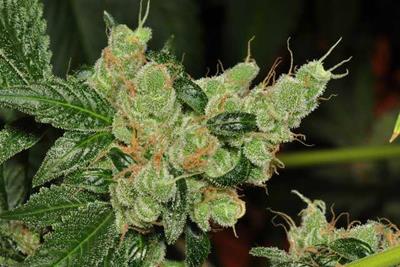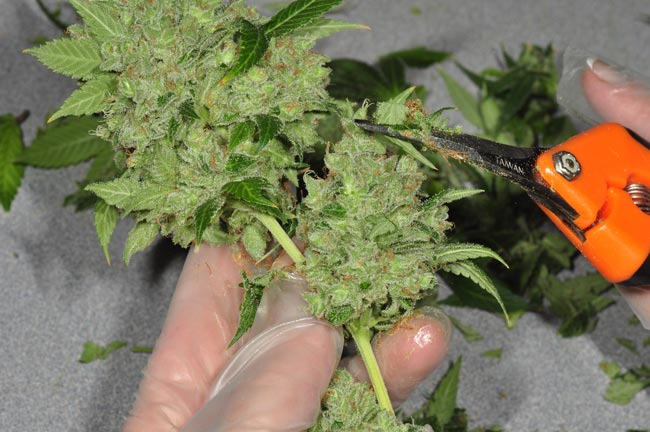
Tuesday December 7, 2021
By Trevor Ross
 Growing
Growing
Growing cannabis can be a deeply rewarding process, but it can also be a frustrating one for first-time growers, with several steps that all need to go at least mostly right for a final product to emerge. After putting months into growing your plant, it would be a shame for that effort to be lost due to an improper harvest. We already offer several guides regarding home growing, including how to get started, but it’s worth taking a closer look at the end of the process, when it's time to harvest, and how.
In this article, we identify when marijuana is ready to harvest, plus review tips for trimming and curing harvested cannabis.
How to Know When to Harvest Marijuana
When growing something like tomatoes you want to harvest the fruit at peak maturity, when the fruit is plump and colorful, but before it begins to fade and wither. Harvesting marijuana is no different, except we’re looking for peak maturity not in fruits or even the flowers themselves, but the trichomes on the flowers.
Trichomes are the milky white glands, about the size of a pinhead, that cover the leaves of the plant, giving it a frosted appearance. And it’s those trichomes that contain all the cannabinoids and terpenes that give marijuana its signature psychotropic effects.
Trichomes grow in clear, but begin to cloud over as the cannabinoids develop within. In fact, if you leave plants unharvested too long, the trichomes will continue to cloud into an amber color as the THC within transforms into CDB and CBN. Some home growers alter their cannabinoid ratios this way, but most prefer to harvest at peak potency.

The first sign that it’s time, or nearly time, to harvest is the pistils — the fine white hairs on your buds — will begin to shrivel from white to an orange, amber, or even brown color. The exact shade depends on the strain you’re growing, but all white hairs mean it's too early to harvest.
Once the pistils do begin to change, however, it’s time to stop any further nutrients and begin flushing your plants. Go ahead and harvest when about 2/3 of the pistils have changed color.
A more accurate way to assess the plant is to watch the trichomes, preferably with a USB microscope or a jeweler’s loupe, whatever helps you see the little things. You can even use your cell phone with a bit of tweaking.
When you can watch the glassy bulbs develop cloud and color, you can more accurately choose your preferred date to harvest. 50-70% cloudiness is ideal, much past that will begin to change color and cannabinoid composition, ideally leaning toward a more relaxed body high.
Harvesting Cannabis Plants
After the buds have matured and the plants have been flushed of excess nutrients, it’s time to cut them down. For those harvesting indoor plants, larger fan leaves can be trimmed from the plant in the days leading up to harvest to increase air flow and light exposure to the buds, but outdoor plants (which already receive ample light and airflow) can remain completely intact until the big chop.
Plants should be harvested just before their light cycle begins, as this is the time most residual nutrients will be resting in the root and not the stem and leaves of the plant.
To harvest, simply cut the whole plant from its base, leaving the stems intact to make hanging them easier. If the plant is too large, individual branches can be cut instead but note that extra branches are necessary for the initial drying process.
Trimming Cannabis Plants
Trimming is the process of cutting the buds from the plant, while also manicuring them to look nice. Growers have two options at this stage: wet trimming, or dry trimming.
Wet trimming is the choice to cut the buds from as much living (wet) plant matter as possible before drying. Dry trimming is the choice to leave the buds attached to branches until the whole piece is dried, then to manicure the buds. So the choice is to trim then dry, or dry then trim.
Keeping the flowers attached to the branches for a “dry trim” may be wiser if you live in a harsh, dry climate because it gives the buds time to suck those branches dry of any remaining moisture and nutrients.

However, if you attempt this when your climate is already wet, it could keep the buds moist for too long, allowing mold to set in.
Hang whole branches upside down to dry, while wet-trimmed cannabis will likely need a hanging rack to spread out and dry on. Dry cannabis in a dark room preferably between 60-70°F, and around 50% humidity for up to two weeks.
When trimming, be sure to catch and collect the sugar leaves, the small leaves around the buds, that also contain trichomes! These leaves are less potent than the buds, but can still be smoked, or extracted into edibles. And have a razor or similar edge nearby to scrape your scissors, which will get sticky with psychoactive sap.
Curing Cannabis for Optimum Flavor and Potency
Regardless of when you decided to harvest, and how to chose to trim, a good grow operation should always end with a careful cure. Curing is a controlled dehydration process that will leave your bud resistant to mold, and further develop both flavor and potency.
The best container for curing is a wide-mouth mason jar, preferably one with a rubber seal. Plastic containers are not recommended because they can, over time, impart a plastic smell to anything inside them.
Fill the jars or other container about ¾ full, keeping the buds loose like popcorn. Many growers also add a small digital hydrometer to the jar, aiming for 60-65% humidity. In this controlled environment, bacteria will chew away at excess starches and sugars in the plant matter, which would otherwise taste bitter when smoked. Open the jars once a day, “burping” out the used air and letting a little fresh air in, before repeating the process again the next day. After the first week, “burping” can be reduced to once every few days.
A minimum cure of two weeks is recommended, but many growers choose to continue this process for about six weeks. Some growers cure their weed for up to six months, as flavors will continue to develop and refine over time.
Summary
The easiest way to tell when your cannabis is nearing harvest is by studying the pistils, or fine white hairs that grow from the cannabis buds. When the pistils begin to turn from white to orange, your plant is nearly ready, and it's time to start making preparations and flushing out nutrients. Once the pistils are about 70% orange, it will be time to harvest. Anything beyond that, and the cannabinoids in the trichomes will begin to turn from THC into other cannabinoids like CBD and CBN.
The most accurate way to tell when it’s time to begin harvesting marijuana is by studying the trichomes. Trichomes are the tiny glands across the surface of a cannabis flower. Using a USB microscope or a lens like a jeweler’s loupe, watch over time as the trichomes turn from clear, to cloudy, toward an amber color. The cloudiness is the cannabinoids inside, and the peak time to harvest is when those trichomes are 50-70% cloudy, and before they begin turning color. Amber trichomes indicate more CBD, and often result in a more relaxed body high (of course, some growers may choose to “over ripen” their plants to achieve this effect).
Most plants will provide a generous window of a week or so in which to harvest, and harvesting a little late won’t spoil your crop, though it may offer a different experience with a different cannabinoid composition. Regardless of when you choose to harvest, always follow it up with a careful curing process to maximize potency and flavor.
Frequently Asked Questions
What do trichomes look like when ready to harvest?
Trichomes will appear milky white when marijuana is ready to harvest. Trichomes that are still clear are too young, and trichomes turning amber or orange have overdeveloped, and the THC in those trichomes is turning to CBD and CBN.
When should I stop watering before harvesting?
Many growers stop all nutrient additives 7-10 days before harvesting, and stop watering altogether about 3 days before harvesting. The flush of clean water is meant to eliminate excess fertilizers from the plant, and the final drought is a strategy to stress the plants into one last effort of developing flowers before harvest.
Can I harvest the top half of my plant?
Yes. In many cases, buds will not all ripen simultaneously. This means it’s not uncommon to harvest a few branches at a time as they come ready, while allowing the remaining buds to continue developing. However, if too many branches are cut from a plant at one time, it can also shock the plant, stunting any further growth.
When do you harvest cannabis, and how do you tell it's ready? Let’s continue this discussion in the comments below!







